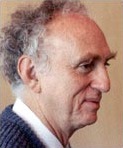Martin L. Perl
| Martin Lewis Perl | |
|---|---|
 |
|
| Born |
June 24, 1927 New York City, New York |
| Died | September 30, 2014 (aged 87) Palo Alto, California |
| Nationality | United States |
| Fields | Physics |
| Institutions |
University of Michigan Stanford Linear Accelerator Center (SLAC) University of Liverpool |
| Alma mater | NYU-Poly and Columbia University |
| Doctoral advisor | I. I. Rabi |
| Doctoral students | Samuel C. C. Ting, Valerie Halyo |
| Known for | Tau lepton |
| Notable awards | Nobel Prize in Physics in 1995 |
Martin Lewis Perl (June 24, 1927 – September 30, 2014) was an American physicist who won the Nobel Prize in Physics in 1995 for his discovery of the tau lepton.
Perl was born in New York City, New York. His parents, Fay (née Resenthal), a secretary and bookkeeper, and Oscar Perl, a stationery salesman who founded a printing and advertising company, were Jewish immigrants to the US from the Polish area of Russia.
Perl is a 1948 chemical engineering graduate of Brooklyn Polytechnic Institute (now known as NYU-Poly) in Brooklyn. After graduation, Perl worked for the General Electric Company, as a chemical engineer in a factory producing electron vacuum tubes. To learn about how the electron tubes worked, Perl signed up for courses in atomic physics and advanced calculus at Union College in Schenectady, New York, which led to his growing interest in physics, and eventually to becoming a graduate student in physics in 1950.
He received his Ph.D. from Columbia University in 1955, where his thesis advisor was I.I. Rabi. Perl's thesis described measurements of the nuclear quadrupole moment of sodium, using the atomic beam resonance method that Rabi had won the Nobel Prize in Physics for in 1944.
Following his Ph.D., Perl spent 8 years at the University of Michigan, where he worked on the physics of strong interactions, using bubble chambers and spark chambers to study the scattering of pions and later neutrons on protons. While at Michigan, Perl and Lawrence W. Jones served as co-advisors to Samuel C. C. Ting, who earned the Nobel Prize in Physics in 1976.
...
Wikipedia
